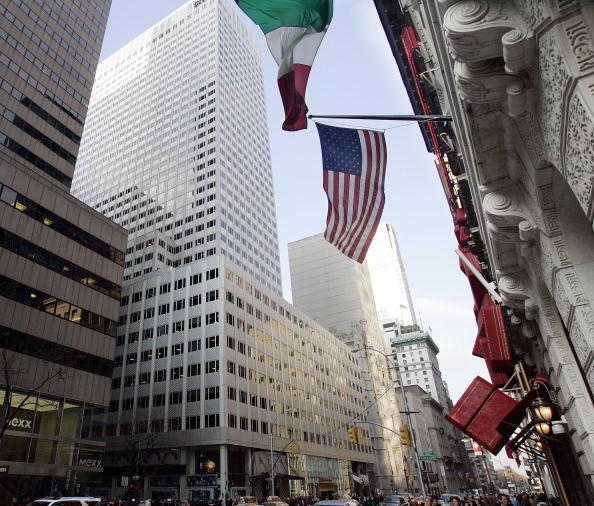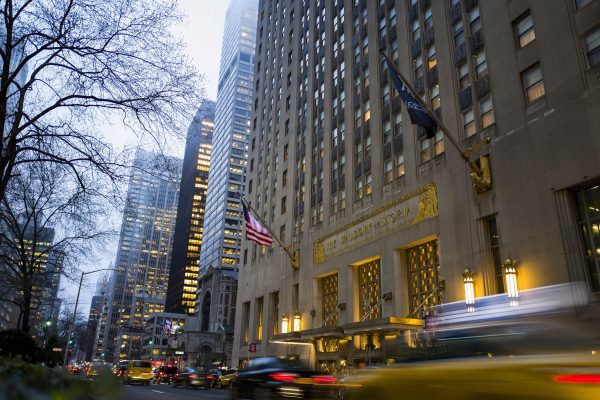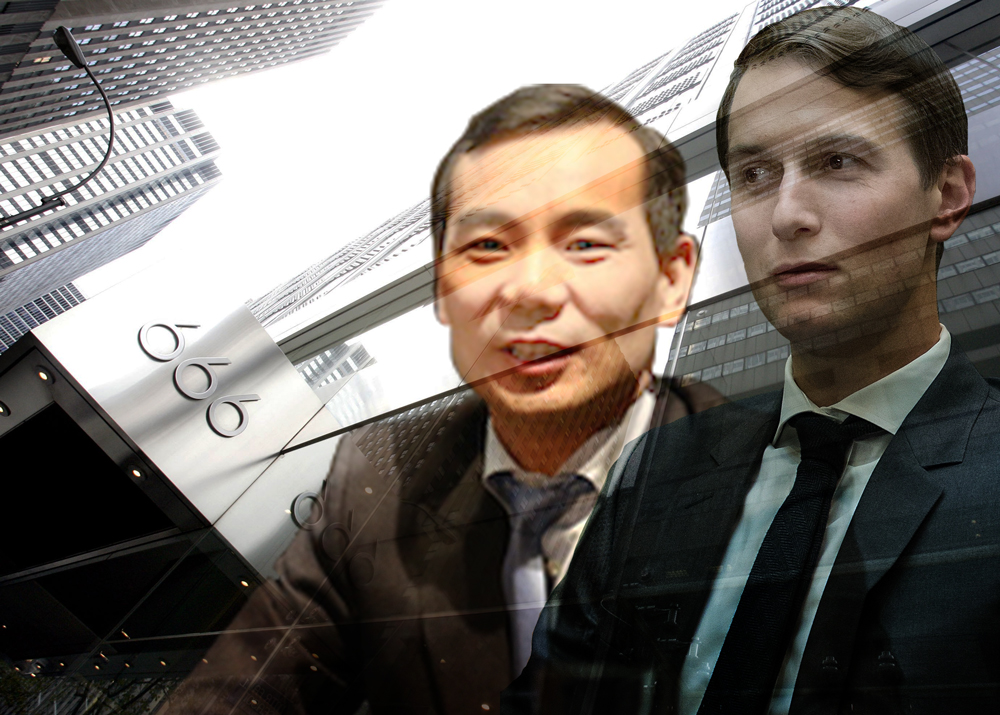The deal that put Jared Kushner [TRDataCustom] on the map also nearly destroyed him. In January 2007, his family firm, Kushner Companies, paid a then-record $1.8 billion for 666 Fifth Avenue, a 41-story office-and-retail tower that was the firm’s first major asset in Manhattan.
“In this particular transaction, we bought really the center of the world,” Kushner told The Real Deal in October 2007, a few months after the purchase. “It doesn’t get any better than that.”
Things went south from there. Critics had slammed the deal for being overleveraged – cash flow at the time of the purchase covered only 65 percent of the debt service – and indeed, Kushner eventually needed to work out a deal with the lenders and bring in Vornado Realty Trust as a partner in order to hold onto the asset.
All through the ordeal, he kept the faith. And if one read Bloomberg’s piece from Monday about an impending deal to bring Chinese insurer Anbang into the tower at terms highly favorable to Kushner Companies, it’d be easy to view the transaction as a home run for the firm and for Vornado.
According to Bloomberg, Anbang agreed to pay Kushner Companies $400 million and assume the lion’s share of the burden of redeveloping the building, adding luxury residential condominiums to the upper floors and revamping the retail. Anbang would seek a construction loan of over $4 billion for the project, according to the story, and Kushner Companies, which committed to a $750 million investment in the tower’s retail portion, would retain a 20 percent stake in the property. Vornado would walk away with a fat profit.
Several market observers, however, told TRD that the numbers, no matter how they’re spun, just don’t make sense. Some even questioned Anbang’s commitment to the property, saying the news reports could serve as a way for Kushner Companies to court other interested investors even if the Chinese insurer walks away.
Computer says no

666 Fifth Avenue (Credit: Getty Images)
“The capital stack [for 666 Fifth],” said one luxury condo developer active in the market, “is insane.” The investor documents obtained by Bloomberg estimate that the completed redevelopment will be worth $7.2 billion. For the project to pencil out at those numbers – even assuming very rosy projections for the office and retail components – the partnership would have to be underwriting the condos at an average of up to $9,000 per square foot, the developer said. That’s a price not even the most ostentatious of the current crop of buildings has come close to – 432 Park Avenue, for example, was asking an average of $6,894 per square foot, according to an analysis by TRD in January 2014. And it’s had to offer significant discounts to buyers.
Just 24 Manhattan sales have closed at north of $7,000 per square foot between the second quarter of 2015 and the first quarter of 2017, according to data provided to TRD by appraisal firm Miller Samuel. That’s an average of three sales per month.
“This [price point] would be an attempt to move Billionaires’ Row Onto Fifth Avenue,” said Jonathan Miller, CEO of Miller Samuel.
Another red flag is the size of the construction loan. At $4 billion, it would be many multiples of anything sought for a project of its type. Some of the city’s most prominent residential developers are chasing, with mixed success, construction loans in the $1 billion-range; HFZ Capital’s Ziel Feldman, for example, is in advanced talks with the Children’s Investment Fund to provide a $1.2 billion loan at 76 11th Avenue, while Gary Barnett, who is trying to score a $900 million loan for Central Park Tower, had to refinance existing land loans on the project because he couldn’t find the money in time.
Michael Stoler, who works on financing deals at Madison Realty Capital, called the $4 billion figure at 666 Fifth “crazy” – even if it factors in the $850 million in EB-5 funds that Kushner and Anbang are seeking.
“The only way this type of deal is going to be done is with the Chinese banks and then it’s going to be a structured deal,” he said, speculating that Anbang’s relationship with lenders like the Bank of China or the Industrial and Commercial Bank of China could help attract the needed funds. CMBS lenders have largely stopped doing construction loans, and banks balk at putting this much risk on their balance sheets.
“I could not see an American bank going into this type of deal,” he said.
Related Companies and Oxford Properties Group have landed around $5 billion in construction financing for an office tower at 30 Hudson Yards and the project’s nearby retail component, but the package was made up of smaller individual loans and involved a handful of owner-occupied office condo deals. Related is now in the market for a $2.56 billion loan to fund an office tower 50 Hudson Yards (projected total cost: $4 billion), and SL Green Realty last year landed a $1.5 billion loan from a syndicate of banks to fund the construction of its Midtown East office project One Vanderbilt.
But both projects are office towers where an anchor tenant has already signed on to take a big chunk of the space at a set rent, making them more palatable to lenders. Residential condo projects, in contrast, are now looked upon more warily by lenders because the income from them is harder to predict – how deep is the buyer pool for ultra-luxury apartments coming to the Midtown market three years or so from now?
One developer who considered – and then abandoned – converting a trophy Midtown office tower into condos is David Bistricer. In 2013, Bistricer’s Clipper Equity and Joseph Chetrit bought the Sony Building at 550 Madison Avenue for $1.1. billion and announced plans to convert the top floors into condos. They were reportedly in the market for a $1.4 billion loan to pay for the conversion, but changed course and sold the tower to the Olayan Group in 2016.
Bistricer argued that it’s too early to judge Kushner and Anbang’s $4 billion price tag without more information. For example, it wasn’t clear whether the figure includes a refinancing of the tower’s existing $1.15 billion mortgage debt. If that’s the case, and if the partners land $850 million in EB-5 funds as hoped, they would only need a pure construction loan of around $2 billion. Still a very large sum, but more manageable.
Bistricer argued that 666 Fifth’s smaller floor plates near the top lend themselves to a condo conversion. “There’s lot of light up there, it’s a great block,” he said. “You can make it work.”
Kushner Companies and Anbang are also looking to turn several lower floors into retail space, according to the New York Post. Sources told TRD that Kushner Companies was in talks with Spanish billionaire Armancio Ortega, whose company Inditex (parent to retail giant Zara) owns a large retail condo at the property, to partner with them on revamping the building’s retail and buying out some of the existing tenants.
“The amount of money they have to pay to buy out existing tenants is astronomical,” said one developer who’d heard about discussions at the property. “Which is what is driving the cap stack so high.”
And Stoler said that the few experiments with retail on multiple floors, such as Related’s Time Warner Center, have not yielded the desired returns, in part because it’s tough to get enough foot traffic on higher floors to justify pricey rents. And the retail market is softening in pricey neighborhoods like SoHo the Meatpacking District and, yes, Midtown.
Anbang – will they or won’t they?

Waldorf Astoria Hotel (Credit: Getty Images)
Anbang was a rather obscure name outside of China before it decided to take on the U.S. real estate market. After it paid the Blackstone Group $1.95 billion for the iconic Waldorf Astoria in early 2015, Anbang’s chairman, Wu Xiaohui, suddenly became the big man on campus – he was written about in the Financial Times and Forbes, gave a talk at Harvard and rubbed shoulders with Henry Kissinger and Michael Bloomberg. Anbang also purchased the Strategic Hotels & Resorts portfolio from the Blackstone Group, but stumbled very publicly on a bid to purchase Starwood Hotels & Resorts. After entering a bidding war with Marriott International that drove the Starwood bid up to $14 billion, Anbang abruptly pulled out without explanation.
The company, which this year had a reported $295 billion in assets under management, has been mulling an initial public offering in Hong Kong, but its opaque ownership – the New York Times reported in September that it’s controlled by small-time Chinese merchants and villagers with ties to Wu, who is married to the granddaughter of former paramount leader Deng Xiaoping — has made it a tough prospect for an IPO, Bloomberg reported.
In January, the Times reported that Kushner and his father Charles met with Wu at the Waldorf Astoria in November and discussed a joint venture on 666 Fifth. The Anbang chief reportedly toasted to Donald Trump, Kushner’s father-in-law and now the U.S. president, adding that he would like to meet Trump. Soon after the story broke, Kushner sold his stake in 666 Fifth to a family-controlled trust.
If a deal between Kushner Companies and Anbang is finalized, it could add to Wu’s clout in China, according to Minxin Pei, a professor who focuses on Chinese politics.
“He [Wu] is purchasing political prestige, and that is a priceless asset for somebody like him,” Pei told the Times on March 14, after Bloomberg’s report on the agreement.
But some expressed doubt that Anbang would see the deal through, and the insurer has done nothing to calm those jitters. In a statement, a spokesperson for the company said Tuesday that “the information about Anbang investment in 666 Fifth Avenue is not correct, there is no investment from Anbang for this deal.” Bloomberg, too corrected its story, changing its headline from “Kushners set to get $400 million from Chinese” to “may get $400 million,” thus adding further confusion to the equation.
And, for now, at least, Kushner Companies is staying mum. A spokesperson for the firm would only say that it “is in active discussions around 666 5th Avenue, and nothing has been finalized.” When asked to comment about the deal at a Wednesday panel, Laurent Morali, president of Kushner Companies, said: “I don’t want to talk about that right now.”
(Click here to see a selection of transactions at 666 Fifth Avenue in our Deal Sheet)
